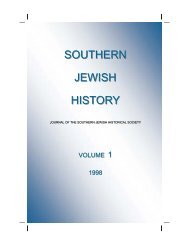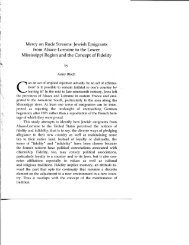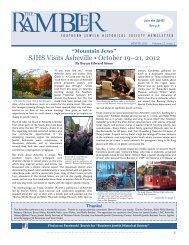A Shtetl Grew in Bessemer - Southern Jewish Historical Society
A Shtetl Grew in Bessemer - Southern Jewish Historical Society
A Shtetl Grew in Bessemer - Southern Jewish Historical Society
You also want an ePaper? Increase the reach of your titles
YUMPU automatically turns print PDFs into web optimized ePapers that Google loves.
18 SOUTHERN JEWISH HISTORY<br />
Rabbi Myron Silverman from Birm<strong>in</strong>gham’s Temple Emanu-El<br />
officiat<strong>in</strong>g. 81 In 1944, Ela<strong>in</strong>e Becker was confirmed by Rabbi<br />
Milton L. Grafman who had replaced Rabbi Silverman at Temple<br />
Emanu-El <strong>in</strong> 1941. 82 These examples reflect how proximity<br />
to a larger <strong>Jewish</strong> community could foster the ma<strong>in</strong>tenance of<br />
ritual. 83<br />
<strong>Bessemer</strong>’s <strong>Jewish</strong> population was stable from 1907 through<br />
the 1940s. 84 From a total of 100 <strong>in</strong>dividuals <strong>in</strong> 1907, the number<br />
<strong>in</strong>creased slightly to 111 <strong>in</strong> 1927 85 , out of the city’s overall population<br />
of just over 20,000 <strong>in</strong> 1930. 86 By 1938 there were<br />
approximately forty-three <strong>Jewish</strong> families <strong>in</strong> <strong>Bessemer</strong>. 87 Shortly<br />
after the end of World War II, <strong>Bessemer</strong>’s <strong>Jewish</strong> population aga<strong>in</strong><br />
totaled 111 people. 88<br />
Dur<strong>in</strong>g the 1940s family ceremonies and observances regard<strong>in</strong>g<br />
<strong>Jewish</strong> rituals varied. While most did not keep strictly<br />
kosher, neither did they eat the proscribed pork and shellfish. As<br />
Marv<strong>in</strong> Cherner <strong>in</strong>dicated, after his grandparents passed away,<br />
while his family still observed the “special rules for Passover,”<br />
they modified its eat<strong>in</strong>g strictures. 89 Ela<strong>in</strong>e Becker has memories<br />
of her mother pick<strong>in</strong>g her up from school every day dur<strong>in</strong>g<br />
Passover and driv<strong>in</strong>g her home for lunch “to observe the holiday.<br />
I can still taste the ‘sweetness’ of the Dr. Pepper that had apparently<br />
been blessed by the Rabbi.” 90<br />
Alv<strong>in</strong> Barr, who with his parents came to <strong>Bessemer</strong> every<br />
Sunday to have lunch with his paternal grandparents, Mart<strong>in</strong> and<br />
Jenny Barr, and his Aunt Dora, Uncle Harry, and cous<strong>in</strong>s Ela<strong>in</strong>e<br />
and Sylvia Ray Hart, can still visualize the ritual of those Sunday<br />
meals:<br />
My grandparents did the cook<strong>in</strong>g. We’d eat, and what I remember<br />
most about it was my grandmother would never sit down at<br />
the table with us. She would always stay <strong>in</strong> the kitchen and<br />
wouldn’t eat until everyone else had eaten. I th<strong>in</strong>k that’s a tradition<br />
from way back <strong>in</strong> Russia. . . . Often she’d cook tsimmes, a<br />
conglomeration of meat, potatoes, and prunes. I know a lot of<br />
people wouldn’t <strong>in</strong>clude the prunes, but I enjoyed it. She’d have<br />
homemade pumpernickel bread too. 91







